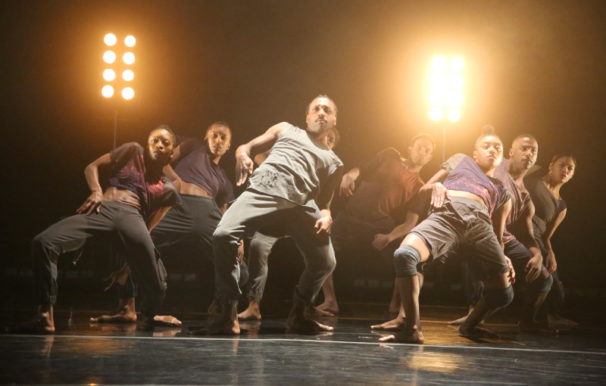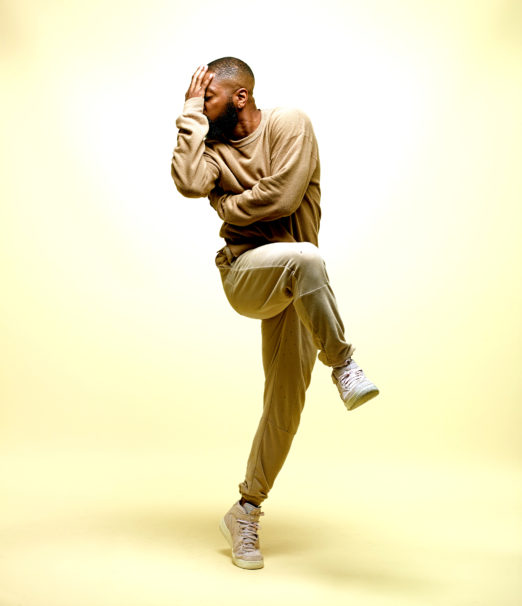
It’s been a minute since Kyle Abraham’s velvety, street-smart choreography hit the dance-friendly stage of the Carpenter Performing Arts Center. In 2015 at the Center, Abraham was one of four choreographers to partner ballet goddess Wendy Whelan in the much-heralded “Restless Creature.” That minute has now extended to five years. On January 25, audiences from Long Beach and beyond will have the rare opportunity to view Abraham’s wicked-good ten-member company, Abraham in Motion (A.I.M.), in a mixed-repertory program at the Carpenter Center.
This hot-hot-hot booking is a feather in the cap of Megan Kline Crockett, the Center’s Executive Director, whose perseverance nabbed A.I.M. “I first saw Kyle at a friend’s recommendation when I was in New York,” she says. “I took the subway through a blizzard to Brooklyn for [his] showcase – it was absolutely stunning—and I vowed to bring him to Long Beach. It took three more years, but we got him here!”
Abraham, a 2013 MacArthur ‘genius’ grant awardee (among other accolades), has hit a sweet spot in the contemporary dance space. He is a maven at mixing genres, giving form to a core vocabulary of fluid hip-hop along the strictures of fully staged modern dance. He is very brilliant with sound scores and video projections. Abraham has completed commissions for dance-kingpins Alvin Ailey American Dance Theater, Paul Taylor Dance Company, and Martha Graham Dance Company. Astonishingly—and with great success—he recently created a work for a classical soloist from New York City Ballet as well as a solo for Misty Copeland.
Abraham has been a player in moving dance away from abstraction and back into real-world issues like apartheid, police brutality, aging. And his dancers are sublime. Their rigorous training and oozing style is inimitably KA.
Speaking in his quiet voice by phone from New York (although he spends a good deal of time in Los Angeles), Abraham readily admits the origins of his dance career: the club world of his teen years growing up in Pittsburgh. (He is perhaps the art world’s most prominent Pittsburgher since Andy Warhol.)
Many dancers pursue their passion in rebellion. But for Abraham, it was different. “My parents were super supportive. My mother even got me a fake i.d. so I could go to the club! They would pick me up at three in the morning; I never did drugs, I was just dancing.”
That memory informs “Drive” (2017), a work celebrating the ecstasy of the club experience. “I made ‘Drive’ to get back to a rawer sense of urban vibe,” he says, adding, “it’s a fun piece to watch.” But it’s not all sensuality, as Abraham notes: “There is a hidden agenda in the piece. It is at the heart, if you listen to the lyrics.” That added message comes courtesy of Barak Obama. “There is Obama’s voice, but unintelligible. I toyed around with several endings but this was the one [I settled on.]”
“The Quiet Dance” (2011) speaks in a “very different tone and pace and mood. It also taps personal material,” says Abraham. “It came at a precarious time. I started getting awards and a lot of opportunity, but I was struggling with change. My father was in hospice care. There is much in the work that deals with the idea of an outsider being inside the group, but having the ending being a beautiful transition.”

“Show Pony,” an aptly named, brief solo work will be danced by company stalwart, Marcella Lewis, who is from Los Angeles. Abraham created the virtuoso, tongue-in-cheek solo for a company member who was graduating from The Juilliard School.
“It’s really just a lot of fun,” says Abraham. “It’s kind of ridiculous in certain ways, the title alone, when you think about putting dance on display. We’re showing what you can do after four years in a college dance program: turn, find arabesque, do floor work, do some krumping; it’s kind of an in-joke that she has mastered all these genres.”
The final work of the program, “Solo Olos” (1976), is by choreographer Trisha Brown, who passed away in 2017. In the witty dance, four dancers perform three phrases forward and backward to instructions from a fifth dancer. This is the kind of conceptual art for which Brown was so highly acclaimed.

Abraham describes working with major dancers like Copeland and Whelan with quiet humility. “It’s daunting to work with a celebrated dancer like Misty,” he admits. “But I love working with people; it’s the sharing that makes the work successful.” A mega-muscled body like Copeland’s is not intimidating. “A body is a body,” says Abraham. “It is the passion and openness that comes from inside that makes the artist.”
“I am a huge fan of Trisha Brown’s work,” he says. “‘Solo Olos’ is a mental challenge for the dancers and audiences in a fun way; you have to pay attention to who is doing what; you are seeing a dance being created on the spot. It looks different every time.”
A.I.M. is hopscotching toward Long Beach via Seville and Stuttgart. It then proceeds to the Kennedy Center and to France. This is something not-to-be-missed for residents of the South Bay who did not drive north to the Broad Stage, or CAP UCLA where the troupe had prior Southern California performances —this is a dance company du moment that delivers.
A.I.M. by Kyle Abraham | Carpenter Performing Arts Center | Jan 25

Marcella Lewis is a LACHSA dance graduate